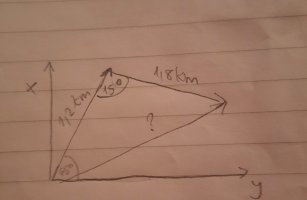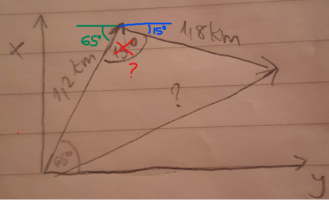The sailboat sails to the northeast at an angle of 65 ° to the east. After 1.2 km and a short stop, the sailboat changes direction and continues to sail to the southeast at an angle of 15 ° to the east, making a shift of 1.8 km. Find the total displacement of the sailboat. Do the problem through the cosine theorem
You are using an out of date browser. It may not display this or other websites correctly.
You should upgrade or use an alternative browser.
You should upgrade or use an alternative browser.
Vector
- Thread starter Dzano
- Start date
D
Deleted member 4993
Guest
If I were to do this problem, I would first draw a sketch of the situation described. If you have drawn such a sketch, please share it with us.The sailboat sails to the northeast at an angle of 65 ° to the east. After 1.2 km and a short stop, the sailboat changes direction and continues to sail to the southeast at an angle of 15 ° to the east, making a shift of 1.8 km. Find the total displacement of the sailboat. Do the problem through the cosine theorem
Please show us what you have tried and exactly where you are stuck.
Please follow the rules of posting in this forum, as enunciated at:
Please share your work/thoughts about this problem
If I were to do this problem, I would first draw a sketch of the situation described. If you have drawn such a sketch, please share it with us.
Please show us what you have tried and exactly where you are stuck.
Please follow the rules of posting in this forum, as enunciated at:
Please share your work/thoughts about this
dx= 1.2 × cos 65° + 1.8 × cos (360° - 15°)
dx= 0.51 + 1.74
dx= 2.25 km
dy= 1.2 × sin 65° + 1.8 sin (360°-15°)
dy= 1.088 - 0.47
dy= 0.62 km
d²= dx² + dy²
d= 2.33 km

I did it this way and my result is correct, but it was not done by the cosine theorem as required in the problem
Dr.Peterson
Elite Member
- Joined
- Nov 12, 2017
- Messages
- 16,117
Your problem is probably that you labeled the angle incorrectly. Here is where the 15 should go:dx= 1.2 × cos 65° + 1.8 × cos (360° - 15°)
dx= 0.51 + 1.74
dx= 2.25 km
dy= 1.2 × sin 65° + 1.8 sin (360°-15°)
dy= 1.088 - 0.47
dy= 0.62 km
d²= dx² + dy²
d= 2.33 km
View attachment 33016
I did it this way and my result is correct, but it was not done by the cosine theorem as required in the problem

Try again, calculating that angle correctly and applying the Law of Cosines.
But good work using components of the vectors!
I got that angle is 100 ° and when I included in the equation c² = a² + b²-2abcos100 ° I got the same 2.33 kmYour problem is probably that you labeled the angle incorrectly. Here is where the 15 should go:
View attachment 33017
Try again, calculating that angle correctly and applying the Law of Cosines.
But good work using components of the vectors!
Can you explain to me how using the 345 ° angle in the first case and the 100 ° angle in the second case I get the same solution?
Thanks for the hint
Dr.Peterson
Elite Member
- Joined
- Nov 12, 2017
- Messages
- 16,117
You did entirely different things with those two angles! You yourself said that you didn't use the Law of Cosines the first time, but you did the second time. Different work uses different angles, so nothing should be surprising.I got that angle is 100 ° and when I included in the equation c² = a² + b²-2abcos100 ° I got the same 2.33 km
Can you explain to me how using the 345 ° angle in the first case and the 100 ° angle in the second case I get the same solution?
Thanks for the hint
The 100° angle is the angle between two sides of the triangle. The 345° angle is the direction of the second vector, which you used to find its components.
